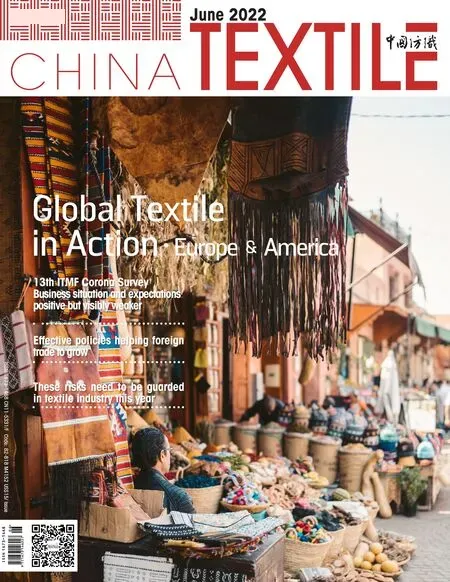13th ITMF Corona Survey Business situation and expectations positive but visibly weaker
ZURICH — May 12, 2022 — In the 2nd half of March 2022, the ITMF conducted the 13th ITMF Corona Survey amongst more than 220 compa—nies around the world in all segments along the textile value chain. For the sixth time since May 2021, companies were asked the same set of ques—tions about their business situation, business expectation, order intake, order backlog, and capacity utilization rate. In addition, they were asked about their main concerns and whether and to what extent they can pass on recent costs increases.
On average across all regions and all segments, the business situation in March 2022 remains in positive territory with +14 percentage points. Nev—ertheless, this is well below the +26 percent in November 2021 and the +18 percent in January 2022. That a relative high number of companies (43%) judge their situation as satisfactory shows that demand remains strong de—spite the many challenges companies are facing on the supply side like de—layed deliveries and higher production costs.
When it comes to the business expectations in six months’ time, the global textile value chain remains optimistic but stands on a much weaker foundation. Since September 2021 the balance between more favorable and less favorable business expectations has fallen from +32 percent to +7 per—cent. This is a clear indication that the textile value chain has passed the tip of a strong business cycle in the 4th quarter of 2021. Whether we will see a broader albeit slower economic growth in the future will depend very much on whether disrupted global supply chains will be rebalanced and how the Rus—sian war in Ukraine will develop in the coming months.
A look at the different regions reveals that the business situation is in positive territory in all regions except for East Asia and Africa where the bal—ance between good and bad business situation is negative. The expectations on the other hand vary strongly. In North, South America and Africa companies anticipate a more favorable busi—ness, while in all other regions the balance between more and less favorable is negative.
As for the different segments the downstream seg—ments – weavers/knitters, finishers/printers, and gar—ment and home textile producers – are generally strug—gling more than the upstream segments – fiber produc—ers, spinners, and textile machinery producers. This is especially true when it comes to passing on higher costs.
The order intake has fallen from a high level of +38 percent in November 2021 to +12 percent in March 2022. This reflects the weaker business situation. Likewise, also order intake expectations deteriorated in March 2022 from +34 percent in January to +22 percent in March 2022.
Since July 2021 order backlog rose from 2.3 to 3.1 months. The expectations for order backlog remain unchanged at 2.9 months. The capacity utilization rate stays at around 80%. The expectations are unchanged given the persistent chain bottlenecks.
Higher costs for raw materials, energy, and trans—portation are the main concerns for companies. Weaker demand is another worry though not a dominant one. On average across the supply chain companies can only pass on 40% of the additional costs.

